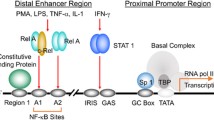Summary
The endogenous tumor-associated macrophage content and recruitment of labeled peritoneal exudate cells into experimental murine B16 melanoma metastases has been examined at different stages in the progressive growth of metastatic lesions. The recruitment of thioglycollate-elicited peritoneal exudate cells and peritoneal exudate cells activated in vitro with muramyl dipeptide was studied. Tumor-associated macrophages and labeled peritoneal exudate cells were identified in paraffin sections by specific histochemical staining and their density in individual metastases measured morphometrically. The density of tumor-associated macrophages and exogenously recruited peritoneal exudate cells was high in very small lesions but decreased rapidly as a function of enlargement of metastases, MD:An; where MD is macrophage density, A is the cross-sectional area of the lesion and n is a negative number. No significant difference was observed in the recruitment of activated and nonactivated peritoneal exudate cells. These results suggest that decreased recrutiment of macrophages from the circulation may explain the decrease in the density of tumor-associated macrophages as metastases grow and indicate that macrophage activation is not accompanied by enhanced localization and/or uptake of macrophages into metastases.
Similar content being viewed by others
References
Adams DO, Hamilton TA (1984) The cell biology of macrophage activation. Ann Rev Immunol 2:283
Blusse' van Oud Alblas A, Mattie H, van Furth R (1983) A quantitative evaluation of pulmonary macrophage kinetics. Cell Tissue Kinet 16:211
Bugelski PJ, Kirsh RL, Poste G (1983) New histochemical method for measuring intratumoral macrophages and macrophage recruitment into experimental metastases. Cancer Res 43:5493
Bugelski PJ, Kirsh RL, Sowinski JM, Poste G (1985) Changes in the macrophage content of lung metastases at different stages in tumor growth. Am J Pathol 118:419
Deodhar SD, James K, Chiang T, Edinger M, Barna BP (1982) Inhibition of lung metastases in mice bearing a malignant fibrosarcoma by treatment with liposomes containing human C-reactive protein. Cancer Res 42:5084
Ettinghausen SE, Rosenberg SA (1986) The adoptive immunotherapy of cancer using lymphokine activated killer cells and recombinant Interleukin-2. Springer Semin Immunopathol 9:51
Fey F, Arnold W, Graffi A (1976) Demonstration of the stimulation of the reticulohistiocytic system (RHS) of mice by treatment with BCG by means of biometric and histochemical techniques. Eur J Cancer 12:595
Fidler IJ (1974) Inhibition of pulmonary metastases by intravenous injection of specifically activated macrophages. Cancer Res 34:1074
Fidler IJ (1981) Therapy of spontaneous metastases by intravenous injection of liposomes containing lymphokines. Science 208:1469
Fidler IJ, Poste G (1982) Macrophage-mediated destruction of malignant tumor cells and new strategies for the therapy of metastatic disease. Springer Semin Immunopathol 5:161
Fidler IJ, Barnes Z, Fogler WE, Kirsh R, Bugelski P, Poste G (1982) Involvement of macrophages in the eradication of established metastases following intravenous injection of liposomes containing macrophage activators. Cancer Res 42:496
Gorelik E, Wiltrout RH, Copeland D, Herberman RB (1985) Modulation of formation of tumor metastases by peritoneal macrophages elicited by various agents. Cancer Immunol Immunother 19:35
Hibbs JB (1974) Discrimination between neoplastic and nonneoplastic cells in vitro by activated macrophages. J Natl Cancer Inst 53:1487
Kalish R, Brody NI (1983) The effects of tumor facilitating factor of B16 melanoma on the macrophage. J Invest Dermatol 80:162
Keller R, Jones V (1971) Role of activated macrophages and antibody in inhibition and enhancement of tumor growth in rats. Lancet II:847
Nash JRG (1982) Macrophages in human tumors: An immunohistochemical study. J Pathol 136:73
Normann SJ, Cornelius J (1978) Concurrent depression of tumor macrophage infiltration and systemic inflammation by progressive cancer growth. Cancer Res 38:3453
Roser B (1965) The distribution of intravenously injected peritoneal macrophages in the mouse. Aust J Exp Biol Med Sci 43:553
Sone S, Fidler IJ (1981) In vitro activation of tumoricidal properties in rat alveolar macrophages by synthetic muramyl dipeptide encapsulated in liposomes. Cell Immunol 57:42
Wood GW, Gallahon KA (1977) Detection and quantitation of macrophage infiltration into primary human tumors with the use of cell surface markers. J Natl Cancer Inst 59:1081
Author information
Authors and Affiliations
Rights and permissions
About this article
Cite this article
Bugelski, P.J., Kirsh, R., Buscarino, C. et al. Recruitment of exogenous macrophages into metastases at different stages of tumor growth. Cancer Immunol Immunother 24, 93–98 (1987). https://doi.org/10.1007/BF00205584
Received:
Accepted:
Issue Date:
DOI: https://doi.org/10.1007/BF00205584




